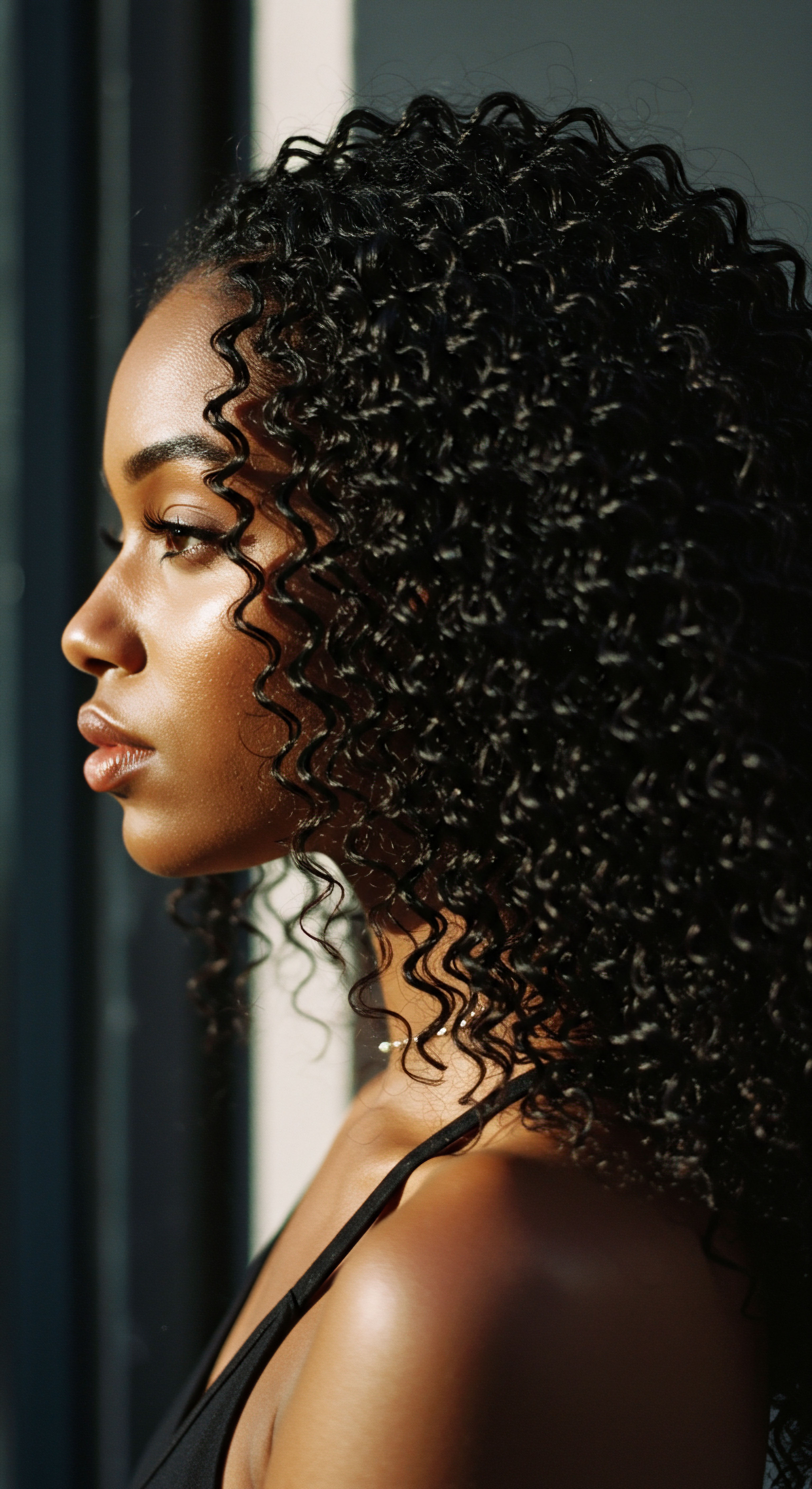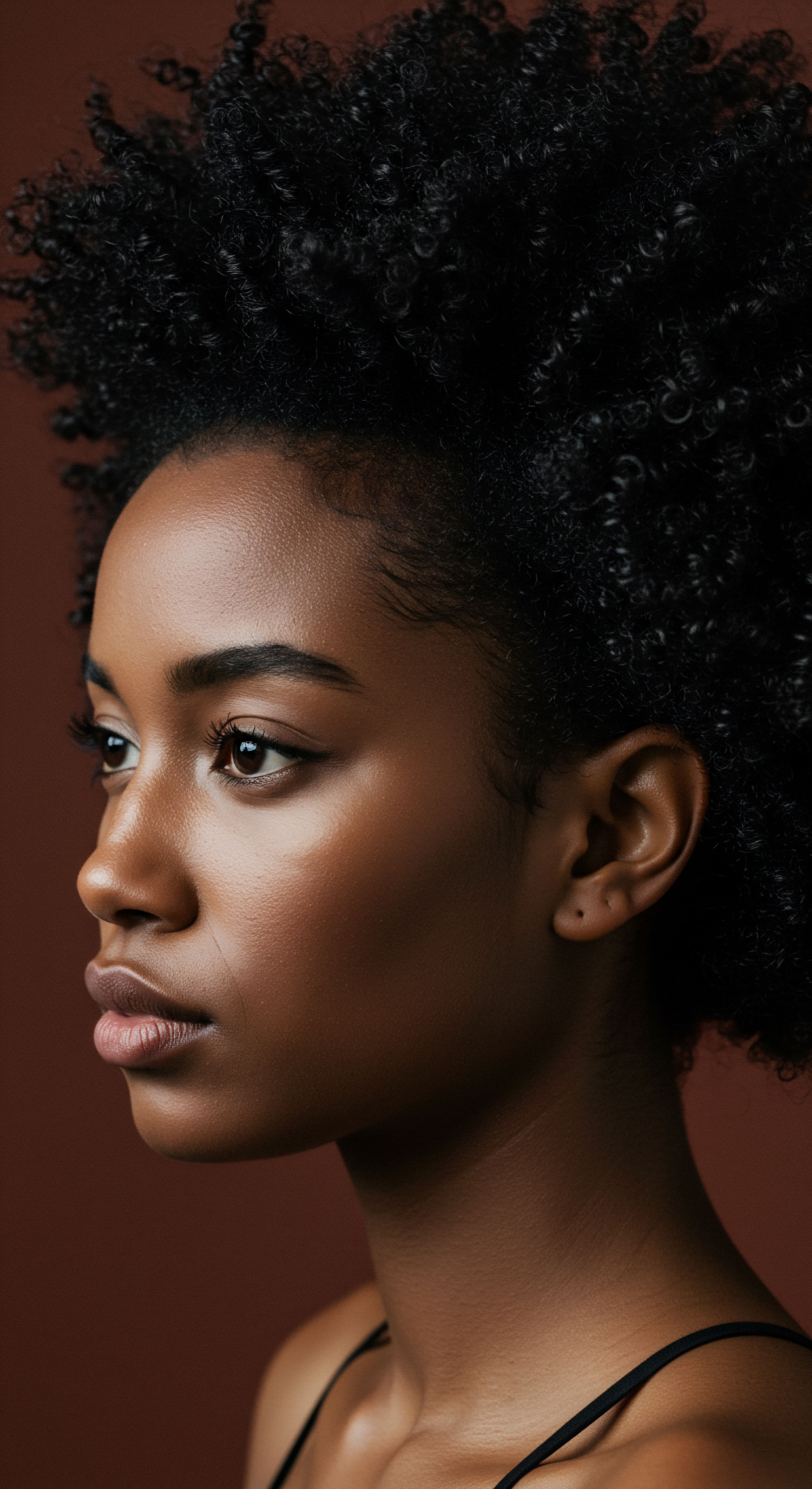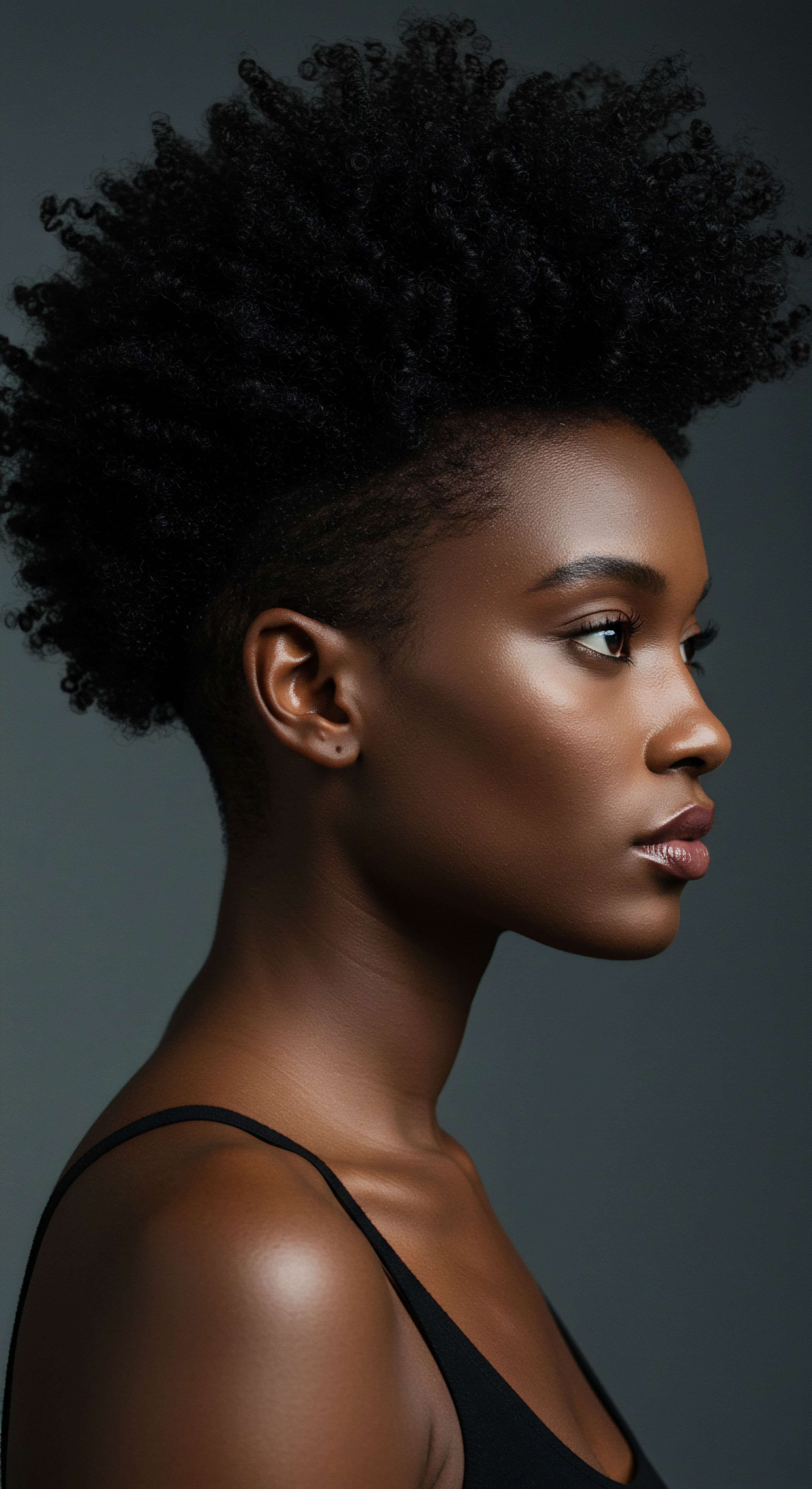
Roots
The quiet hum of static electricity, a subtle yet persistent disruption for those with textured hair, often prompts a search for respite. We find ourselves drawn to solutions that promise calm and order for our coils and curls. Among these, silk stands as a whisper of ancient wisdom, a material whose touch seems to hold a particular magic.
Its reputation for minimizing friction and preserving hair’s natural state has echoed through generations, making it a revered choice for hair care. To truly appreciate silk’s capacity to quiet static, we must first look to the fundamental interactions between hair and its surroundings, delving into the very essence of why textured strands often bear the brunt of electrical imbalances.

Understanding Static Electricity on Hair
Static electricity arises from a simple, yet profound, dance of electrons. When two dissimilar materials come into contact and then separate, electrons can transfer from one surface to another. This transfer creates an imbalance of electrical charges ❉ one object gains electrons and becomes negatively charged, while the other loses electrons and becomes positively charged. Hair, being a natural protein fiber, readily participates in this exchange.
When hair rubs against another surface, like a cotton pillowcase or a synthetic scarf, electrons can jump between the hair and the fabric. This leaves hair strands with an uneven charge, often a positive one. Because like charges repel, these newly charged strands push away from each other, resulting in the familiar “flyaway” effect, frizz, and general unruliness.
The environment plays a significant part in this phenomenon. Static electricity is more prevalent in dry conditions, particularly during colder months when indoor heating reduces air humidity. In such environments, there is less moisture in the air to conduct away the accumulated electrical charges, allowing them to build up on hair strands. This lack of humidity means the charges linger, making hair more prone to becoming frizzy, brittle, and even leading to breakage.
Static electricity on hair stems from electron transfer between surfaces, leaving strands with an uneven charge that causes repulsion and visible frizz.

Hair Anatomy and Its Electrical Nature
Our hair, at its very core, is a complex biological structure. Each strand is primarily composed of keratin, a fibrous protein. The outermost layer of the hair shaft is the cuticle, a protective shield made of overlapping cells, much like shingles on a roof. When hair is healthy and well-hydrated, these cuticle scales lie flat, creating a smooth surface that reflects light and minimizes friction.
However, when hair becomes dry or is subjected to mechanical stress from rough fabrics, the cuticle scales can lift and separate. This creates a rougher surface, increasing friction and making the hair more susceptible to electron transfer and static buildup. Textured hair, with its unique bends, coils, and curves, naturally has more points of contact and therefore more opportunities for friction between individual strands and external materials. This inherent structure can make textured hair particularly prone to static disruption.
The protein composition of hair itself, and its inherent electrical properties, influence how it interacts with other materials. The presence of electrons within hair fibers makes the flow of static electricity relatively easy, leading to the development of a static charge.

The Triboelectric Series and Hair Interactions
To understand how materials exchange electrons, scientists use the triboelectric series. This is a ranking of materials based on their tendency to gain or lose electrons when rubbed against another substance. Materials higher on the list tend to lose electrons and become positively charged, while those lower on the list tend to gain electrons and become negatively charged. The farther apart two materials are on this series, the greater the charge transfer when they rub together.
Human hair typically sits on the positive side of the triboelectric series, meaning it tends to lose electrons and acquire a positive charge when rubbed against many common fabrics. For example, when hair rubs against materials like wool or certain synthetic fabrics, hair often gives up electrons, becoming positively charged, while the other material gains them. This creates the electrical imbalance that results in static.
| Material Human Hair |
| Tendency to Charge Positive (+) |
| Material Nylon |
| Tendency to Charge Positive (+) |
| Material Wool |
| Tendency to Charge Positive (+) |
| Material Silk |
| Tendency to Charge Slightly Positive (+) |
| Material Paper |
| Tendency to Charge Slightly Positive (+) |
| Material Cotton |
| Tendency to Charge Neutral (0) |
| Material Polyester |
| Tendency to Charge Negative (-) |
| Material Acrylic |
| Tendency to Charge Negative (-) |
| Material This simplified series illustrates how different materials interact electrically. |
The position of silk on this series is particularly insightful. While silk can build up a small amount of static charge, it is less likely to do so than many synthetic fabrics or even wool. This relative neutrality or slight positive charge, when compared to the positive charge hair often acquires, means less dramatic electron transfer, leading to less static buildup.

Ritual
Having explored the fundamental dance of electrons that leads to static hair, we now turn our attention to the deliberate choices we make in our daily hair care. This section delves into the practical wisdom of incorporating silk into our routines, transforming a simple material into a cornerstone of a serene hair care ritual. The gentle touch of silk, a practice rooted in historical understanding, offers a tangible path toward mitigating static, preserving moisture, and honoring the inherent beauty of textured strands.

Why Does Silk Prevent Static on Textured Hair
Silk’s remarkable ability to quell static on textured hair arises from a combination of its unique physical and chemical properties. At its heart, silk is a natural protein fiber, composed primarily of fibroin and sericin. These proteins are made up of amino acids like glycine, alanine, and serine, giving silk a structure that interacts harmoniously with human hair, which is also protein-based.
One of silk’s primary defenses against static is its exceptionally smooth surface. Unlike cotton or other rougher fabrics, which possess microscopic fibers that can snag and tug at hair cuticles, silk allows hair strands to glide effortlessly across its surface. This reduction in mechanical friction is paramount. When hair rubs against a rough surface, it creates friction, leading to the transfer of electrons and the subsequent static charge.
A study published in the Journal of Cosmetic Dermatology, for instance, indicated that silk’s smooth surface can reduce hair friction by up to 43% compared to other materials. This diminished friction means fewer electrons are exchanged, significantly reducing the likelihood of static electricity building up.
Beyond its smoothness, silk possesses intrinsic moisture-retaining properties. Textured hair, by its very nature, tends to be drier and more prone to moisture loss, which exacerbates static problems. Dry hair lacks the conductivity to dissipate electrical charges, allowing them to accumulate readily. Silk, however, is less absorbent than cotton and helps hair maintain its natural hydration levels.
Its protein structure, particularly the amino acids like serine and glycine, has hygroscopic qualities, meaning they attract and hold water molecules. By preventing hair from becoming overly dry, silk helps to ensure that hair remains sufficiently hydrated. Hydrated hair is more conductive, allowing any minor static charges to dissipate more easily, rather than building up and causing flyaways.
Silk’s smooth surface minimizes friction, reducing electron transfer and static charge buildup, while its moisture-retaining properties keep hair hydrated, allowing any charges to dissipate naturally.

How Silk Differs From Other Fabrics
The distinction between silk and other common fabrics, particularly cotton and synthetic satins, highlights its anti-static prowess.
- Cotton ❉ While natural and breathable, cotton is highly absorbent. It readily draws moisture and natural oils away from hair, leaving strands dry and more susceptible to static. The microscopic fibers of cotton also create significant friction, roughing up the hair cuticle and promoting static charge.
- Synthetic Satin ❉ Often confused with silk due to its smooth appearance, satin is a weave, not a fiber, and is typically made from polyester or nylon. These synthetic materials are known to generate static electricity more readily than natural fibers. While satin may feel smooth, it often lacks silk’s breathability and moisture-retaining capabilities, and can still trap heat and moisture, potentially leading to issues for hair.
- Silk ❉ As a natural protein fiber, silk’s unique molecular structure allows it to reduce static electricity. It is a poor conductor of electricity, meaning it does not allow electric charges to flow through it easily, which makes it less likely to generate static electricity than other fabrics. Some research even indicates that silk naturally contains positive and negative ions, which, upon contact with other materials, can help balance electrical charges, neutralizing them and preventing buildup.

The Historical Whispers of Silk and Hair
The use of silk for hair protection is not a recent discovery; it is a practice with deep historical roots, a testament to ancestral wisdom that recognized silk’s gentle qualities long before modern science articulated the reasons. Across diverse cultures, silk has been a cherished material for hair wraps, bonnets, and scarves, serving both practical and symbolic purposes.
In ancient China, where silk production originated, silk hair wraps were commonly used by women to protect their hair, maintain elaborate hairstyles, and even signify social status. The Tang Dynasty saw silk become more accessible, extending its use to women of varying social strata. Similarly, in Japan, the traditional “kazashi” was often a silk hair wrap used to adorn and protect intricate hairdos, with geishas notably using silk to preserve their styles during sleep.
Moving westward, in India, silk was revered for its luxurious feel and cultural significance, with its use in hair care traceable to ancient texts. Indian women employed silk scarves to shield their hair from dust, sun, and pollution, valuing its smooth texture for reducing friction and preventing breakage. Persian women, too, utilized silk wraps to protect their hair from harsh desert climates and maintain its luster. Even in the Victorian era, nightcaps made of silk were worn to keep hair tangle-free and promote gloss.
The revival of silk bonnets in recent decades, particularly within the Black community, underscores this enduring cultural connection. Recognized for their role in protecting natural hairstyles, silk bonnets have become a symbol of Black beauty rituals, emphasizing hair care and preservation. This historical continuum demonstrates a shared understanding across civilizations ❉ silk offers a gentle embrace for hair, preserving its integrity and beauty.

Relay
As we move beyond the immediate touch of silk, a deeper inquiry into its scientific underpinnings reveals a complex interplay of molecular structure, electrical properties, and moisture dynamics that truly define its anti-static capabilities. This section seeks to unravel those intricacies, connecting the visible effect of static reduction to the subtle, yet powerful, mechanisms at the microscopic level, drawing on scientific understanding and challenging conventional perceptions.

Does Silk’s Molecular Structure Influence Static?
The very architecture of silk fibers, particularly the primary protein fibroin, plays a significant part in its electrical behavior. Fibroin is structured with long chains of amino acids, predominantly glycine, alanine, and serine, which arrange themselves into beta pleated sheets. This highly ordered, crystalline structure contributes to silk’s strength, flexibility, and notably, its smooth surface.
While some materials readily conduct electricity, silk is a poor conductor. This means that unlike certain synthetic fabrics that allow static charges to build and spread easily, silk resists the flow of electrons. When friction occurs, the limited conductivity of silk means that fewer electrons are readily exchanged or retained on its surface.
Instead of facilitating a significant charge transfer, silk’s inherent properties tend to suppress the accumulation of static electricity. This is a subtle yet crucial distinction ❉ silk does not necessarily prevent electron transfer entirely, but it certainly minimizes the build-up of a significant charge that would cause hair strands to repel each other dramatically.
Furthermore, hydrolyzed silk protein, when applied to hair or skin, can form a thin protective film. This film acts to lower friction between hair strands or between hair and its environment, thereby reducing the potential for static generation. Its moisture-binding ability also enhances conductivity, facilitating the discharge of accumulated charge. This suggests a dual action ❉ reduced friction at the surface and improved charge dissipation through enhanced moisture.

How Does Environmental Humidity Alter Hair Static?
The ambient humidity levels are a critical, often overlooked, factor in the static dance of hair. In environments with low humidity, such as heated indoor spaces during winter, hair becomes drier. This dryness reduces the hair’s natural conductivity.
Water molecules in the air act as natural conductors, allowing electrical charges to dissipate from surfaces. When the air is dry, this pathway for charge dissipation is largely absent, permitting static charges to accumulate on hair strands more readily.
Consider a compelling observation ❉ in a study on hair friction and various fabrics at 40% relative humidity, luxury silk consistently registered as the smoothest material. This suggests that even under conditions where static could be a factor, silk’s physical properties still offer a superior advantage in minimizing friction. The presence of moisture, whether from the air or retained within the hair fiber itself due to silk’s properties, allows for a more balanced electrical environment around the hair. When hair is adequately moisturized, the electrical charges have a pathway to neutralize, preventing the visible effects of static.
This is why humidifiers are often recommended in dry climates to combat static hair. They increase the moisture content in the air, which in turn helps hair to remain hydrated and allows static charges to discharge. Silk acts as a micro-environment within this larger atmospheric context, helping to preserve the hair’s inherent moisture, thus mimicking, in a localized way, the protective effects of higher humidity.

Is There a Cultural Resonance in Silk’s Anti-Static Properties?
The adoption of silk for hair care across various cultures is not merely a coincidence; it reflects an intuitive understanding of its properties that predates modern scientific explanation. While the exact scientific mechanisms were unknown, generations observed the tangible benefits ❉ smoother hair, reduced tangles, and a certain vibrancy that persisted. This experiential knowledge became woven into hair rituals and traditions.
The consistent use of silk bonnets, durags, and scarves in the African American community, for example, highlights a profound cultural recognition of silk’s protective qualities for textured hair. These practices developed out of a necessity to preserve intricate styles, protect delicate strands from friction during sleep, and maintain moisture in hair types particularly susceptible to dryness and breakage. The choice of silk was not arbitrary; it was a response to lived experience, a material that consistently delivered on the promise of hair preservation.
This cultural phenomenon serves as a powerful, real-world case study, offering a perspective that moves beyond isolated laboratory findings. While a direct clinical study on silk pillowcases for skin or hair is acknowledged as challenging to fund and conduct, the anecdotal evidence and widespread adoption across centuries and cultures speak volumes. The sustained preference for silk, passed down through generations, acts as a collective endorsement of its efficacy in reducing hair friction and preserving moisture, directly countering the conditions that lead to static. This long-standing cultural affirmation provides a unique, perhaps controversial in its non-traditional scientific format, yet compelling data point to strengthen the argument for silk’s anti-static benefits.

Reflection
The journey through silk’s interaction with textured hair reveals a beautiful synergy of material science and historical wisdom. From the microscopic dance of electrons on the hair shaft to the comforting presence of a silk bonnet, the story unfolds with layers of understanding. We have seen how silk, with its inherent smoothness and moisture-preserving qualities, gently disarms the static charge that can leave textured hair feeling disheveled. The echoes of ancestral practices, combined with contemporary scientific insight, affirm silk’s unique place in hair care.
It is a material that truly speaks to the needs of textured strands, offering not just protection, but a profound sense of care and respect for the hair’s natural beauty. The quiet effectiveness of silk serves as a reminder that sometimes, the most profound solutions are those that work in gentle harmony with nature.

References
- Cook, J. G. (1964). Handbook of Textile Fibres ❉ Natural Fibres. Merrow Publishing Company.
- Kaplan, D. L. et al. (1994). Silk Biomaterials. John Wiley & Sons.
- Lizuka, E. (1996). Silk ❉ Biology, Chemistry, and Processing. Springer.
- Magoshi, J. (1996). Structure and Properties of Silk Fibroin. Springer.
- Leslie, J. F. et al. (2003). The Structure of Fibroin in Silk Fibers. Academic Press.
- Vollrath, F. (1999). Biology of spider silk. International Journal of Biological Macromolecules, 24(2-3), 81-88.
- Wilcke, J. C. (1757). Historia frictionis electricae. Kongl. Svenska Vetenskaps Academiens Handlingar, 18, 25-34.
- Malinauskyte, E. Kang, X. & Gabarra, M. (2023). The Fabric Factor ❉ The Role of Your Pillowcase and Hair Accessories in Hair Care. TRI Princeton.
- Chung, Y. (2016). Sericin ❉ A Biopolymer with Potential in Hair Care. Journal of Cosmetology & Trichology, 2(1).